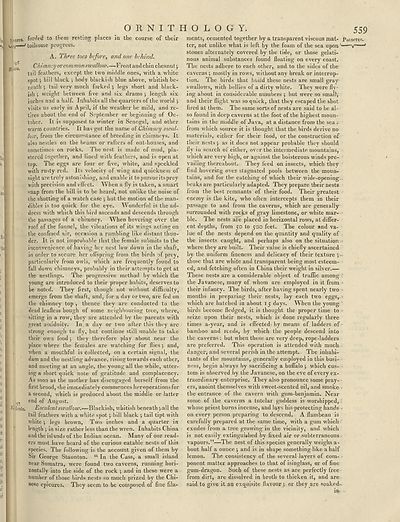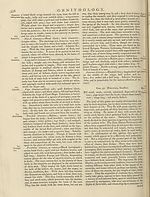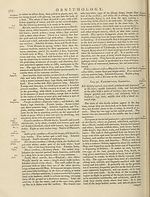Encyclopaedia Britannica > Volume 15, NIC-PAR
(613) Page 559
Download files
Complete book:
Individual page:
Thumbnail gallery: Grid view | List view

R -»•
97
knta.
O R N I T H O
forded to tliem resting places in the course of their
toilsome progress.
A. Three toes before, and one behind.
Chimncy ovcommonswallow.—Front and chin chesnut;
tail feathers, except the two middle ones, with a white
spot •, bill black ; body blackish blue above, whitish be-
reath j tail very much forked *, legs short and black¬
ish j weight between five and six drams ; length six
inches and a half. Inhabits all the quarters of the world ;
visits us early in April, if the weather be mild, and re¬
tires about the end of September or beginning of Oc¬
tober. It is supposed to winter in Senegal, and other
warm countries. It has got the name of Chimney swal¬
low, from the circumstance of breeding in chimneys. It
also nestles on the beams or rafters of out-houses, and
sometimes on rocks. The nest is made of mud, pla¬
stered together, and lined with feathers, and is open at
top. The eggs are four or five, white, and speckled
with rusty red. Its velocity of wing and quickness of
sight are truly astonishing, and enable it to pursue its prey
with precision and effect. When a fly is taken, a smart
snap from the bill is to be heard, not unlike the noise of
the shutting of a watch case ; but the motion of the man¬
dibles is too quick for the eye. Wonderful is the ad¬
dress with which this bird ascends and descends through
the passages of a chimney. When hovering over the
roof of the funnel, the vibrations of its wings acting on
the confined air, occasion a rumbling like distant thun¬
der. It is not improbable that the female submits to the
inconvenience of having her nest low down in the shaft,
in order to secure her offspring from the birds of prey,
particularly from owls, which are frequently found to
fall down chimneys, probably in their attempts to get at
the nestlings. The progressive method by which the
young are introduced to their proper habits, deserves to
be noted. They first, though not without difficulty,
emerge from the shaft, and, for a day or two, are fed on
the chimney top , thence they are conducted to the
dead leafless bough of some neighbouring tree, where,
sitting in a row, they are attended by the parents with
great assiduity. In a day or two after this they are
strong enough to fly, but continue still unable to take
their own food ; they therefore play about near the
place where the females are watching for flies ; and,
when a mouthful is collected, on a certain signal, the
dam and the nestling advance, rising towards each other,
and meeting at an angle, the young all the while, utter¬
ing a short quick note of gratitude and complacency.
As soon as the mother has disengaged herself from the
first brood, she immediately commences heroperationsfor
a second, which is produced about the middle or latter
end of August.
Esculent swallow.—Blackish, whitish beneath all the
tail feathers with a white spot j bill black 5 tail tipt with
white •, legs brown, Two inches and a quarter in
length •, in size rather less than the wren. Inhabits China
and the islands of the Indian ocean. Many of our read¬
ers must have heard of the curious eatable nests of this
species. The following is the account given of them by
Sir George Staunton. “ In the Cass, a small island
near Sumatra, were found two caverns, running hori¬
zontally into the side of the rock •, and in these were a
number of those birds nests so much prized by the Chi¬
nese epicures. They seem to be composed of fine fila-
LOGY. 559
ments, cemented together by a transparent viscous mat- Passeres.
ter, not unlike what is left by the foam of the sea upon '—~v J
stones alternately covered by the tide, or those gelati¬
nous animal substances found floating on every coast.
The nests adhere to each other, and to the sides of the
caverns ; mostly in rows, without any break or interrup¬
tion. The birds that build these nests are small gray
swallows, with bellies of a dirty white. They were fly¬
ing about in considerable numbers •, but were so small,
and their flight was so quick, that they escaped the shot
fired at them. The same sorts of nests are said to he al¬
so found in deep caverns at the foot of the highest moun¬
tains in the middle of Java, at a distance from the sea ^
from which source it is thought that the birds derive no
materials, either for their food, or the construction of
their nests $ as it does not appear probable they should
fly in search oi either, over the intermediate mountains,
which are very high, or against the boisterous winds pre¬
vailing thereabout. They feed on insects, which they
find hovering over stagnated pools between tbe moun¬
tains, and for the catching of which their wide-opening
beaks are particularly adapted. They prepare their nests
from the best remnants of their food. Their greatest
enemy is the kite, who often intercepts them in their
passage to and from the caverns, which are generally
surrounded with rocks of gray limestone, or white mar¬
ble. The nests are placed in horizontal rows, at differ¬
ent depths, from 50 to 500 feet. The colour and va¬
lue of the nests depend on the quantity and quality of
the insects caught, and perhaps also on the situation
where they are built. Their value is chiefly ascertained
by the uniform fineness and delicacy of their texture ;
those that are white and transparent being most esteem¬
ed, and fetching often in China their weight in silver.—
These nests are a considerable object of traffic among :
the Javanese, many of whom are employed in it from -
their infancy. The birds, after having spent nearly two »
months in preparing their nests, lay each two eggs,
which are hatched in about 15 days. When the young
birds become fledged, it is thought the proper time to -
seiz.e upon their nests, which is done regularly three
times a-year, and is effected by means of ladders of
bamboo and reeds, by which the people descend into
the caverns : but when these are very deep, rope-ladders
are preferred. This operation is attended with much
danger, and several perish in the attempt. The inhabi¬
tants of the mountains, generally employed in this busi¬
ness, begin always by sacrificing a buffalo j which cus¬
tom is observed by the Javanese, on the eve of every ex¬
traordinary enterprise. They also pronounce some pray¬
ers, anoint themselves with sweet-scented oil, and smoke ■
the entrance of the cavern with gum-benjamin. Near
some of the caverns a tutelar goddess is worshipped,
whose priest burns incense, and lays his protecting hands ■
on every person preparing to descend. A flambeau is
carefully prepared at the same time, with a gum which
exudes from a tree growing in the vicinity, and which
is not easily extinguished by fixed air or subterraneous
vapours.”—The nest of this species generally weighs a-
bout half a ounce ; and is in shape something like a half
lemon. The consistency of the several layers of com¬
ponent matter approaches to that of isinglass, or of fine
gum-dragon. Such of these nests as are perfectly free
from dirt, are dissolved in broth to thicken it, and are
said to give it an exquisite flavour j or they are soaked'-
in
97
knta.
O R N I T H O
forded to tliem resting places in the course of their
toilsome progress.
A. Three toes before, and one behind.
Chimncy ovcommonswallow.—Front and chin chesnut;
tail feathers, except the two middle ones, with a white
spot •, bill black ; body blackish blue above, whitish be-
reath j tail very much forked *, legs short and black¬
ish j weight between five and six drams ; length six
inches and a half. Inhabits all the quarters of the world ;
visits us early in April, if the weather be mild, and re¬
tires about the end of September or beginning of Oc¬
tober. It is supposed to winter in Senegal, and other
warm countries. It has got the name of Chimney swal¬
low, from the circumstance of breeding in chimneys. It
also nestles on the beams or rafters of out-houses, and
sometimes on rocks. The nest is made of mud, pla¬
stered together, and lined with feathers, and is open at
top. The eggs are four or five, white, and speckled
with rusty red. Its velocity of wing and quickness of
sight are truly astonishing, and enable it to pursue its prey
with precision and effect. When a fly is taken, a smart
snap from the bill is to be heard, not unlike the noise of
the shutting of a watch case ; but the motion of the man¬
dibles is too quick for the eye. Wonderful is the ad¬
dress with which this bird ascends and descends through
the passages of a chimney. When hovering over the
roof of the funnel, the vibrations of its wings acting on
the confined air, occasion a rumbling like distant thun¬
der. It is not improbable that the female submits to the
inconvenience of having her nest low down in the shaft,
in order to secure her offspring from the birds of prey,
particularly from owls, which are frequently found to
fall down chimneys, probably in their attempts to get at
the nestlings. The progressive method by which the
young are introduced to their proper habits, deserves to
be noted. They first, though not without difficulty,
emerge from the shaft, and, for a day or two, are fed on
the chimney top , thence they are conducted to the
dead leafless bough of some neighbouring tree, where,
sitting in a row, they are attended by the parents with
great assiduity. In a day or two after this they are
strong enough to fly, but continue still unable to take
their own food ; they therefore play about near the
place where the females are watching for flies ; and,
when a mouthful is collected, on a certain signal, the
dam and the nestling advance, rising towards each other,
and meeting at an angle, the young all the while, utter¬
ing a short quick note of gratitude and complacency.
As soon as the mother has disengaged herself from the
first brood, she immediately commences heroperationsfor
a second, which is produced about the middle or latter
end of August.
Esculent swallow.—Blackish, whitish beneath all the
tail feathers with a white spot j bill black 5 tail tipt with
white •, legs brown, Two inches and a quarter in
length •, in size rather less than the wren. Inhabits China
and the islands of the Indian ocean. Many of our read¬
ers must have heard of the curious eatable nests of this
species. The following is the account given of them by
Sir George Staunton. “ In the Cass, a small island
near Sumatra, were found two caverns, running hori¬
zontally into the side of the rock •, and in these were a
number of those birds nests so much prized by the Chi¬
nese epicures. They seem to be composed of fine fila-
LOGY. 559
ments, cemented together by a transparent viscous mat- Passeres.
ter, not unlike what is left by the foam of the sea upon '—~v J
stones alternately covered by the tide, or those gelati¬
nous animal substances found floating on every coast.
The nests adhere to each other, and to the sides of the
caverns ; mostly in rows, without any break or interrup¬
tion. The birds that build these nests are small gray
swallows, with bellies of a dirty white. They were fly¬
ing about in considerable numbers •, but were so small,
and their flight was so quick, that they escaped the shot
fired at them. The same sorts of nests are said to he al¬
so found in deep caverns at the foot of the highest moun¬
tains in the middle of Java, at a distance from the sea ^
from which source it is thought that the birds derive no
materials, either for their food, or the construction of
their nests $ as it does not appear probable they should
fly in search oi either, over the intermediate mountains,
which are very high, or against the boisterous winds pre¬
vailing thereabout. They feed on insects, which they
find hovering over stagnated pools between tbe moun¬
tains, and for the catching of which their wide-opening
beaks are particularly adapted. They prepare their nests
from the best remnants of their food. Their greatest
enemy is the kite, who often intercepts them in their
passage to and from the caverns, which are generally
surrounded with rocks of gray limestone, or white mar¬
ble. The nests are placed in horizontal rows, at differ¬
ent depths, from 50 to 500 feet. The colour and va¬
lue of the nests depend on the quantity and quality of
the insects caught, and perhaps also on the situation
where they are built. Their value is chiefly ascertained
by the uniform fineness and delicacy of their texture ;
those that are white and transparent being most esteem¬
ed, and fetching often in China their weight in silver.—
These nests are a considerable object of traffic among :
the Javanese, many of whom are employed in it from -
their infancy. The birds, after having spent nearly two »
months in preparing their nests, lay each two eggs,
which are hatched in about 15 days. When the young
birds become fledged, it is thought the proper time to -
seiz.e upon their nests, which is done regularly three
times a-year, and is effected by means of ladders of
bamboo and reeds, by which the people descend into
the caverns : but when these are very deep, rope-ladders
are preferred. This operation is attended with much
danger, and several perish in the attempt. The inhabi¬
tants of the mountains, generally employed in this busi¬
ness, begin always by sacrificing a buffalo j which cus¬
tom is observed by the Javanese, on the eve of every ex¬
traordinary enterprise. They also pronounce some pray¬
ers, anoint themselves with sweet-scented oil, and smoke ■
the entrance of the cavern with gum-benjamin. Near
some of the caverns a tutelar goddess is worshipped,
whose priest burns incense, and lays his protecting hands ■
on every person preparing to descend. A flambeau is
carefully prepared at the same time, with a gum which
exudes from a tree growing in the vicinity, and which
is not easily extinguished by fixed air or subterraneous
vapours.”—The nest of this species generally weighs a-
bout half a ounce ; and is in shape something like a half
lemon. The consistency of the several layers of com¬
ponent matter approaches to that of isinglass, or of fine
gum-dragon. Such of these nests as are perfectly free
from dirt, are dissolved in broth to thicken it, and are
said to give it an exquisite flavour j or they are soaked'-
in
Set display mode to:
![]() Universal Viewer |
Universal Viewer | ![]() Mirador |
Large image | Transcription
Mirador |
Large image | Transcription
Images and transcriptions on this page, including medium image downloads, may be used under the Creative Commons Attribution 4.0 International Licence unless otherwise stated. ![]()
| Encyclopaedia Britannica > Encyclopaedia Britannica > Volume 15, NIC-PAR > (613) Page 559 |
|---|
| Permanent URL | https://digital.nls.uk/192589667 |
|---|
| Attribution and copyright: |
|
|---|
| Shelfmark | EB.11 |
|---|---|
| Description | Ten editions of 'Encyclopaedia Britannica', issued from 1768-1903, in 231 volumes. Originally issued in 100 weekly parts (3 volumes) between 1768 and 1771 by publishers: Colin Macfarquhar and Andrew Bell (Edinburgh); editor: William Smellie: engraver: Andrew Bell. Expanded editions in the 19th century featured more volumes and contributions from leading experts in their fields. Managed and published in Edinburgh up to the 9th edition (25 volumes, from 1875-1889); the 10th edition (1902-1903) re-issued the 9th edition, with 11 supplementary volumes. |
|---|---|
| Additional NLS resources: |
|

